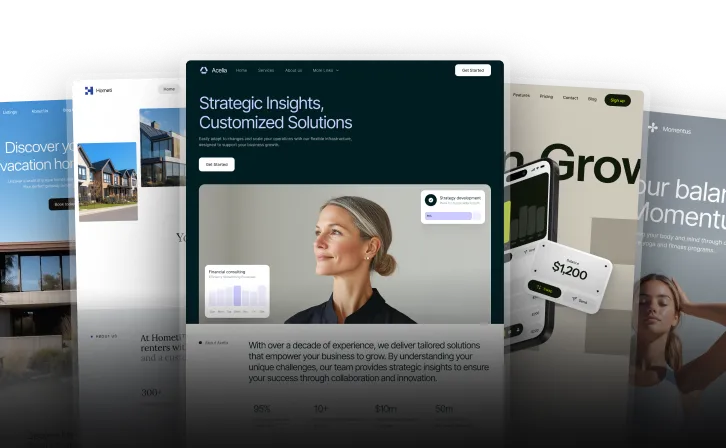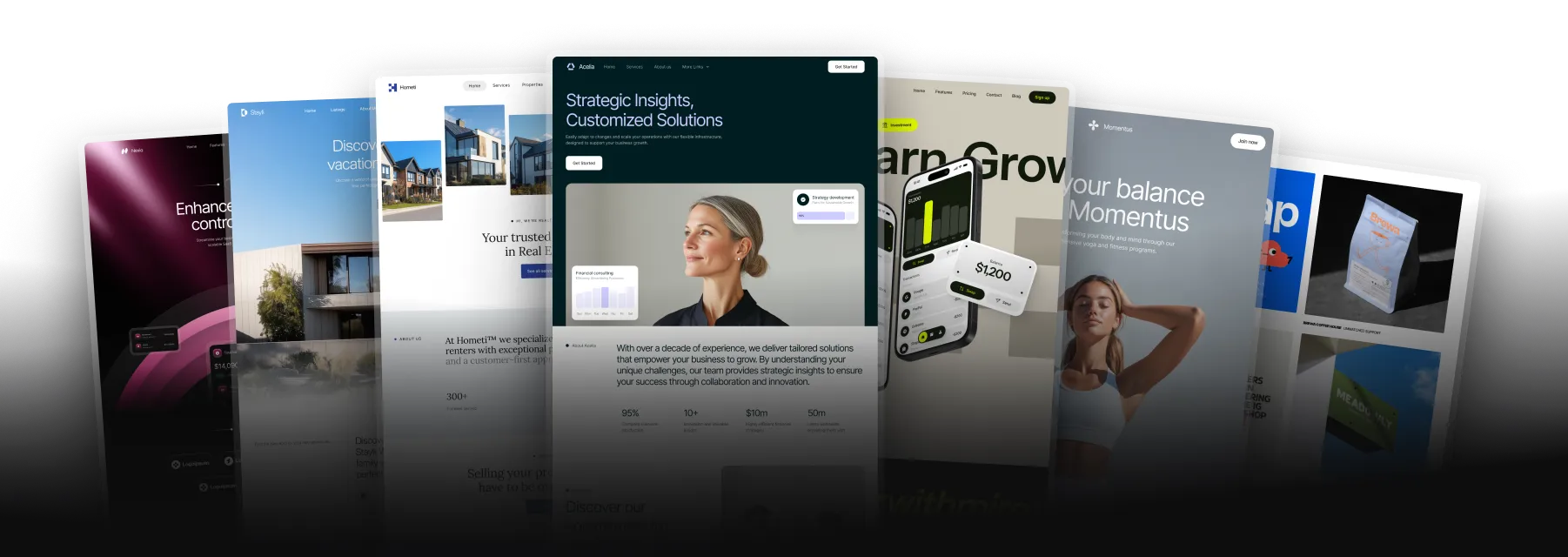The Complete Guide to E-commerce Website Templates
Unlock all templates




E-commerce website templates make it simple to launch an online store without needing technical skills. They save time, reduce costs, and come packed with essential features like shopping carts, payment gateways, and mobile-friendly designs. Here’s a quick summary of what you’ll learn:
- Cost Comparison: Templates cost $79–$129, while custom sites range from $10,000–$250,000.
- Setup Time: Templates take days to weeks; custom sites take months.
- Key Features: SEO tools, mobile optimization, and built-in security.
- Customization: Drag-and-drop tools for easy adjustments.
- Where to Buy: Platforms like Webflow, ThemeForest, and Astra offer great options.
Quick Comparison
| Factor | Templates ($79–$129) | Custom Development ($10,000+) |
|---|---|---|
| Cost | Low | High |
| Setup Time | Days to Weeks | Months |
| Design Options | Pre-tested layouts | Fully tailored |
| Technical Skills | Minimal | Professional expertise needed |
Templates are perfect for small to medium businesses looking for affordability, speed, and professional design without coding expertise.
Why Use E-commerce Templates
Cost and Time Savings
Using templates can significantly reduce expenses and speed up the process compared to building a custom e-commerce site from scratch. Here's a quick breakdown:
| Solution Type | Cost Range | Development Time | Best For |
|---|---|---|---|
| Ready-made Templates | $0-$200 | Days | Small to medium businesses |
| Customized Design | $1,500-$5,000 | Weeks | Growing businesses |
| Enterprise Customization | Up to $50,000 | Months | Large corporations |
This affordability and quick setup make templates an ideal choice for business owners who lack coding expertise but want to launch an online store efficiently.
No-Code Design Options
Templates also cater to non-technical users by offering easy-to-use tools. Many platforms provide drag-and-drop features that let you:
- Adjust layouts effortlessly
- Change colors and fonts to match your brand
- Add product catalogs and integrate payment systems
- Set up navigation menus and contact forms
These tools make it simple for anyone to create a professional-looking online store without hiring a web developer.
Mobile-Ready Design
A mobile-friendly website is a must-have. Modern templates ensure your store looks great and works smoothly on any device by handling technical details like:
- Automatically scaling and optimizing images
- Restructuring menus for mobile screens
- Creating buttons that are easy to tap
- Supporting mobile payment options
- Ensuring fast load times on all devices
WP Astra, a popular template provider, highlights this focus on mobile usability:
"The lightweight and fully responsive eCommerce website templates are built for speed and conversion, helping you sell more with little extra effort."
Similarly, Blocksy emphasizes mobile optimization:
"Build your online store effortlessly with Blocksy's mobile-friendly, customizable eCommerce templates. You can achieve high performance and sales with designs optimized for a seamless shopping experience across all devices."
Best Ecommerce Webflow Templates of 2023
Must-Have Template Features
E-commerce templates aren't just about looks - they also play a big role in performance and functionality. Let’s dive into the key aspects that make a template stand out.
Design Flexibility
Customizing your online store’s design is crucial for creating a strong brand identity. For example, Yeti Cycles saw a 49% jump in page views and an 18% increase in average time on page in 2024 by using design options that allowed dynamic content presentation. Their success was driven by features like:
- Customizable layouts for product displays
- Adjustable menus
- Flexible content blocks for images and other visuals
- Tools for tweaking brand colors, typography, and product page layouts
Good templates combine customizability with smart design. As Mike Montiero puts it, "Design is how we communicate what an object does, or its function, through its shape or form".
Search Engine Ready
A great design isn’t enough if people can’t find your store. SEO tools built into templates help boost your visibility. Consider this: the top Google search result grabs 27.6% of clicks, while only 0.63% of users bother with the second page. Key SEO features to look for include:
- Optimized title tags and meta descriptions
- Clean, user-friendly URL structures
- Mobile-responsive design
- Fast loading speeds
- Schema markup support
- Automatic XML sitemap generation
Take LARQ as an example - by optimizing their site, they achieved a 400% increase in year-over-year revenue in 2024.
Platform and Security Tools
Security is non-negotiable in e-commerce. With 81% of shoppers preferring credit card payments due to fraud protection, templates must include robust security features. Here’s a breakdown:
| Security Feature | Purpose | Impact |
|---|---|---|
| SSL Certificates | Encrypts data | Safeguards customer information during transfer |
| PCI Compliance | Secures payment processes | Ensures safe handling of credit card data |
| Tokenization | Protects sensitive data | Replaces sensitive info with encrypted tokens |
| Multi-factor Authentication | Controls access | Blocks unauthorized admin access |
sbb-itb-fdf3c56
Where to Find Templates
Picking the right e-commerce template can make all the difference for your online store. Below, we outline trusted sources offering templates designed to boost conversions, along with a quick breakdown of what each source provides.
Temlis Template Collection
Temlis specializes in premium templates for Webflow and Framer, tailored for e-commerce. These templates come packed with features to help drive sales. Here's a quick comparison of some popular options:
| Template Name | Price | Key Features | Ideal For |
|---|---|---|---|
| Darken | $79 | Custom product layouts, SEO tools, integrated CMS | Tech products |
| AnderDark | $79 | E-commerce integration, CMS features, responsive design | Digital products |
| Moneta | $79 | Payment gateway integration, financial dashboards | Digital services |
| Vetic | $129 | Product catalogs, service booking, CMS integration | Specialty retail |
For example, Avvinue launched their site in just two weeks using the IndieGo template from Elastic Themes, receiving hundreds of compliments on their design (Elastic Themes Testimonials, 2023).
But Temlis isn't your only option. Several other platforms also offer high-quality templates for different e-commerce needs.
Alternative Template Sources
Looking for more options? Check out these platforms:
-
Framer Marketplace: Known for its user-friendly, conversion-focused templates.
- Free options like "Sonic" for beginners
- Premium templates like "CAVAYA" priced at $49
- Advanced options with Gumroad integration
-
ThemeForest: A budget-friendly platform offering feature-rich templates. For instance, the "Effect" template ($24) includes:
- 22 pre-built pages
- Unlimited color schemes
- Bootstrap 3.1 framework
- Responsive design
-
Astra Starter Templates: Great for niche-specific shops. Their collection includes designs for:
- Clothing stores
- Ceramic shops
- Flower boutiques
- Digital marketplaces
When choosing a template, keep pricing in mind. Webflow's e-commerce plans start at $29/month (with a 2% transaction fee), while Framer offers a basic plan at $15/month for up to 1,000 pages. Free plans are available for testing, but larger e-commerce projects typically require a paid subscription.
How to Modify Templates
Brand Design Changes
Make your template reflect your brand by tweaking key visual elements:
| Design Element | Customization Tips | Impact |
|---|---|---|
| Color Scheme | Adjust headers, buttons, and accents | Builds brand recognition |
| Typography | Stick to 2–3 consistent fonts | Improves readability |
| Logo Placement | Place your logo in the header and footer | Increases brand visibility |
| Image Style | Use consistent product photography | Creates a cohesive look |
For example, AS Colour nailed this in 2024 with a minimalist approach. Their neutral palette of whites and grays made their product images pop. Plus, their clear navigation menu helped showcase product categories without losing brand consistency.
Store Setup Steps
- Product Configuration Organize your product catalog effectively. Badgley Mischka did this in 2024 by using high-quality photos and videos to highlight intricate design details. They also included lifestyle images to help customers picture the products in everyday use.
- Payment Integration Pick payment gateways that fit your business. Popular choices include PayPal, Stripe, and Square.
- Checkout Optimization Chair King Backyard Store improved their checkout process by adding a custom shipping calendar. This feature lets customers easily select delivery dates during checkout.
Once your store is live, focus on fine-tuning its performance to boost visibility and conversions.
Search and Sales Optimization
Improving your template's performance for search engines and conversions can make a huge difference. Data shows that better user experiences can increase conversion rates by up to 400%.
Speed Optimization
- Compress images to maintain quality while reducing size.
- Use lazy loading to speed up initial page loads.
- Keep load times under 3 seconds - 53% of users leave slower sites.
Conversion Elements
Streamline the checkout process and ensure your site works well across regions. With over 40% of shoppers using mobile devices to complete purchases, responsive design is a must if you want to maximize revenue.
E-commerce Design Standards
User Experience Basics
A great user experience is crucial for modern e-commerce success. In fact, investing $1 in UX can yield a $100 return. Here are some key elements to focus on:
| UX Element | Impact | Implementation Tips |
|---|---|---|
| Navigation | Reduces bounce rates | Use clear menus, smart search, and organized filters |
| Mobile Design | Mobile commerce could hit 62% by 2027 | Ensure responsive layouts and easily tappable buttons |
| Loading Speed | Keeps users engaged | Optimize assets and minimize plugins |
| Visual Hierarchy | Shapes first impressions (94% design-based) | Place products strategically and include clear calls to action |
"It doesn't matter how many times I have to click, as long as each click is a mindless, unambiguous choice"
These UX principles align perfectly with the customizable features discussed earlier.
Sales Conversion Tips
Once your UX is solid, focus on elements that drive conversions. For instance, optimized landing pages can significantly boost sales.
-
Trust Signals
Build customer confidence with these strategies:- Display genuine product reviews - 93% of consumers read reviews before buying.
- Show security badges at checkout for reassurance.
- Offer guest checkout options, which can increase conversions by 45%.
-
Purchase Urgency
Avoid surprise fees, as they often lead to cart abandonment. Instead:- Display shipping costs upfront.
- Show real-time inventory levels to encourage quick purchases.
- Use AI-driven personalization - over 70% of online retailers expect it to make a big impact in 2024.
Incorporating these tactics into your templates can create a shopping experience that feels trustworthy and engaging.
Speed Optimization
Fast loading speeds are essential for boosting revenue. Pages that load in 1 second can achieve conversion rates close to 40%, while every extra second of delay reduces conversions by 7%.
"One of our clients had a slow-loading site, so we started by optimizing the images. We made them smaller and compressed them, which made a huge difference in how fast the pages load. In fact, the images now take up 60% less space and load much faster"
Here’s how to speed things up:
- Compress images to under 1MB and use a CDN with caching.
- Enable GZIP compression for faster data transfer.
- Reduce redirects and fix broken links.
Template Selection Guide
Key Points Summary
When picking a template, focus on mobile optimization, speed, platform compatibility, and cost. These factors are crucial for today's mobile-driven shoppers.
Here's a quick breakdown:
| Selection Factor | Impact | Essentials |
|---|---|---|
| Mobile Design | Drives 44% of e-commerce sales | Responsive layouts, touch-friendly elements |
| Loading Speed | 50% of users leave after 3 seconds | Compressed images, minimal plugins |
| Platform Compatibility | Influences long-term growth | Seamless integration with your e-commerce system |
| Cost Structure | Varies widely by platform | Ranges from $29 to $310 for premium templates |
"Choosing the most feature-rich platform is not always the best choice for a business that will not benefit from any of the costly features. It will likely increase the build, maintenance and licensing costs without providing any Return on Investment (ROI)." – Virtina
Next Steps
Related Blog Posts
Recommended posts
Unlock all templates







